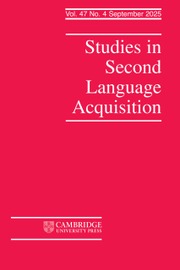No CrossRef data available.
Article contents
Effects of Sociophonetic Variability on L2 Vocabulary Learning
Published online by Cambridge University Press: 26 August 2025
Abstract
Acoustic variability refers to variations in speech that do not alter linguistic content. Previous studies have demonstrated that acoustic variability improves second language (L2) word learning when varying talker, speaking style, or speaking rate but not amplitude or fundamental frequency (Barcroft & Sommers, 2005; Sommers & Barcroft, 2007). The current study examined the effects of region-based sociophonetic variability. In Experiment 1, English speakers attempted to learn German nouns while viewing pictures and listening to the words with low sociophonetic variability (six speakers of one regional variety, one repetition per speaker) and high sociophonetic variability (six speakers of each of six different regional varieties, one repetition per speaker). Participants completed picture-to-L2 and L2-to-first language (L1) posttests. Experiment 2 replicated Experiment 1 while counterbalancing word groups and learning conditions. Results of both experiments revealed increased accuracy for high over low variability, suggesting that regionally varied exemplars of words lead to more robust developing lexical representations.
Information
- Type
- Research Article
- Information
- Copyright
- © The Author(s), 2025. Published by Cambridge University Press


